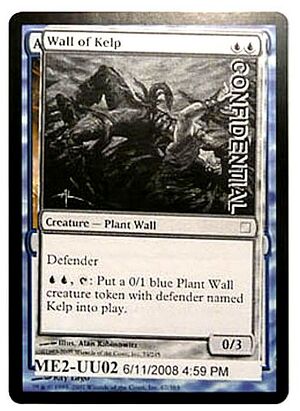Playtest: Difference between revisions
>Sigilbot m (Bot: Adding <!--temp fix-->) |
>Sigilbot m (Bot: Automated text replacement (-\n\<\!\-\-temp fix\-\-\> +)) |
||
| Line 34: | Line 34: | ||
==References== | ==References== | ||
{{Reflist}} | {{Reflist}} | ||
[[Category:Magic: The Gathering]] | [[Category:Magic: The Gathering]] | ||
Revision as of 22:32, 4 June 2014

A playtest is the process by which individual cards, as in card design, or sets of cards, as in decks, are played to test the card or cards for design issues to establish a desired quality. [1] [2]
Playtest cards have specific card codes, to make them recognisable for the playtesters. [3] They are highly confidential. In early 2006, Wizards of the Coast filed a lawsuit against Daron Rutter, an moderator MTG Salvation for posting playtest cards for upcoming Magic: The Gathering card sets. [4] The lawsuit accused him of engaging in copyright infringement, contributory copyright infringement, trade secret violation, unjust enrichment, and breach of contract.[5] The case was settled out of court, and the terms of the settlement have been sealed.[6]
In the context of deck playtesting, this often involves in testing a given deck against popular decks in a format's metagame and accordingly modifying the decklist, its main deck and its sideboard, to better deal with those decks.
References
- ↑ Mark Rosewater (February 11, 2013). "Nuts & Bolts: Initial Playtesting". magicthegathering.com. Wizards of the Coast.
- ↑ Aaron Forsythe (March 19, 2004). "A-Proxy-Mation". magicthegathering.com. Wizards of the Coast.
- ↑ Mark Rosewater (January 12, 2009). "Nuts & Bolts: Card Codes". magicthegathering.com. Wizards of the Coast.
- ↑ Template:Cite web
- ↑ Template:Cite web
- ↑ Template:Cite web